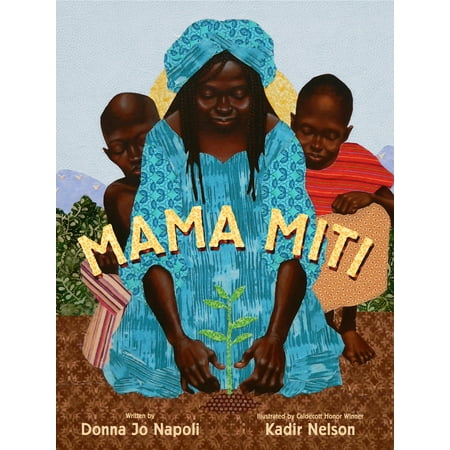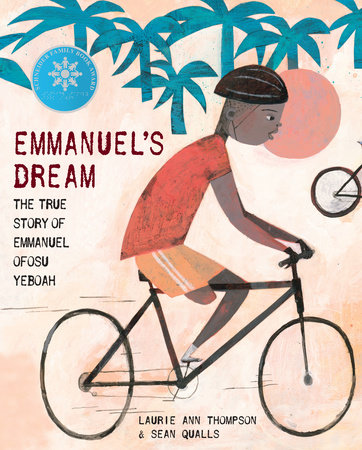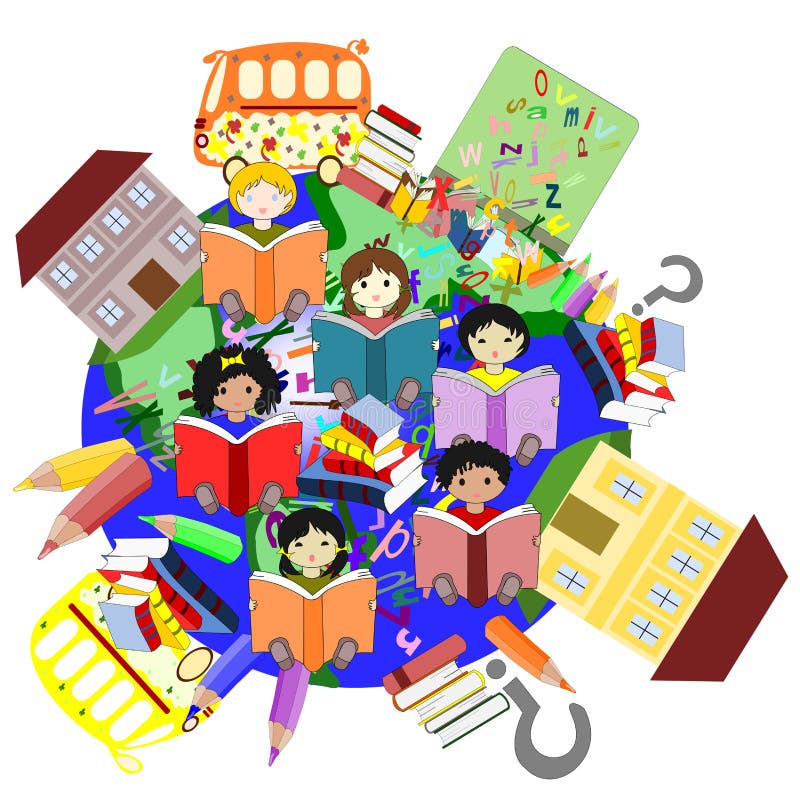How can we inspire children to take action to make the world a better place?
It starts with a BOOK!
About three months ago, a teacher at my school asked if I could order a book for the library entitled “One Plastic Bag: Isatou Ceesay and the Recycling Women of the Gambia“. I looked into it, found it was available and went ahead and ordered it for the library. About that same time, the grade 4 teacher was doing an inquiry project with her class on the effects that plastic is having on our earth, particularly plastics that are ending up in oceans and harming wildlife. I’ve always been concerned about the environment and try to do my part to recycle, compost, and reuse, but when this book ended up in my lap I couldn’t help but be extra inspired by it to change my ways and reduce my use of plastics even more. Not only is this a true story of how women in Gambia made a difference in their community by turning a problem into a solution by dealing with discarded plastic bags, but the book fit in perfectly with what the grade 4 class had been doing in Science with their inquiry project surrounding Earth Day. The students so far had written to the local mayor to ask her to ban plastic straws in the city and reduce use of disposable plastic shopping bags. The students were coming up with solutions on how to deal with the problem of plastics in the ocean and had enthusiasm, concern, and determination to make a difference to the problem of plastics in the ocean. When the grade 4’s were read the book, “One Plastic Bag”, they were further empowered to make a difference and try to create change. Sometimes the right picture book at the right time about creating change for a better world can create a wave of ideas and interest on how to make it happen. This picture book reminded me of the power that books can have in creating world change and finding solutions for difficult world problems.

This book was the starting point for me for compiling a literature canon for children which includes books that inspire children to take action to make the world a better place.
This led me to the graphic novel “I’m Not a Plastic Bag” by Rachel Hope- Allison. Since the grade 4’s have made special presentations to many classes in the school and have hung posters everywhere reminding us to reduce our use of plastic, this graphic novel also inspires us to think about how our use of plastics is effecting the oceans. Also a graphic novel format, it is a genre that connects well with more reluctant readers on this important topic.

The school that I work at has a high South Asian population of approximately 75% of the school community. With this in mind, I wanted to find some inspiring books with main characters of South Asian decent who have helped create positive change in the world. The book titled “Be the Change: A Grandfather Gandhi Story” by Arun Gandhi and Bethany Hegedus is a book that connects with a South Asian audience as well as readers around the world inspiring them to think before they act as their actions will affect others. This picture book also teaches students about the core value of respect in terms of being respectful of material things and not wasting them. Teaching core values such as respect, kindness, empathy, courage, perseverance, and determination is something we are addressing at the school I work at. Books provide a great tool for teaching these important character traits.

This leads me to the next book which also has a strong South Asian character and is based on a true story. The novel Iqbal by Francesco D’Adamo, tackles the difficult subject of child slave labor from the first hand view of Iqbal who suffered abuse as a child in a carpet factory forced to work long hours sometimes chained to the carpet loom. After a teacher does a read-aloud of the story, this story lends itself well to the students having “Grand Conversations”, (Province of Ontario. April 2011, Grand Conversations in Primary Classrooms). “Grand Conversations” develop critical thinking skills as opposed to “Gentle inquisitions” by the teacher where it is mostly the teacher introducing his/her opinions of the message of the book. When students are taught what rich talk about text might sound like, they are able to achieve higher-level comprehension of text and have more authentic lively discussion about the book (Eeds & Wells, 1989). A combination of rich authentic discussion and characters in the book which are South Asian would offer a much stronger connection to the students at this school who are predominately South Asian as opposed to European children’s classics with very little or no South Asian characters or connection to the region.

The story of Malala, is another powerful book to inspire children , especially girls, on how they have the power to make a difference in the world. Malala’s Magic Pencil by Malala Yousafzai, is a picture book based on a true story, with a strong female Pakistani character named Malala Yousafzai who is a activist for female education in Pakistan. This book will especially connect with the large number of students at our school who are South Asian girls.
The picture book “Brave Girl: Clara and the Shirtwaist Makers’ Strike of 1909 by Michelle Markel is another true story of a young female Ukrainian immigrant activist rallying for change against the garment industry for unfair treatment against girls and women. She lead the largest women’s walkout and strike in 1909 and is a great role model for girls and women of the change one women can make in the world. Many of the students at the school are immigrants to Canada and this story is inspirational to a immigrants and non-immigrants.

When many women work together cooperatively in a community, positive long-lasting global change can occur as in the case with the inspiring picture book titled Mama Miti: Wangari Maathai and the Trees of Kenya by Donna Jo Napoli. This is the true story of Wangari Maathai who is a activist, an environmentalist, and a strong west African women who was the first African women to win the Nobel Peace prize. Since there are a few African-Canadian families at the school I work at, it is especially important to have some stories with strong African characters. Mama Miti identified a problem in her home of Kenya (there were not enough trees, which was causing erosion of the soil, and dirty drinking water), and identified a solution ( plant 30 000 000 trees with the help of many women and children in the region).

Every September, we celebrate and acknowledge the difference that people with disabilities can make in the world, specifically Terry Fox, who had a dream to make a difference by raising money for Cancer research by running across Canada on one leg. People who have overcome great obstacles and made a positive change in the world are an inspiration to all of us. Therefore, I believe books with characters with disabilities should be in all canons of children’s literature, no matter what the school demographic as people with disabilities are cross-cultural and their stories should be shared to inspire others to show what people can achieve with determination. The novel
Run by Eric Walters is one of these books which tells the story of Terry Fox and his incredible courage and determination.

Another great story is the Picture Book,
Emmanuel’s Dream: The Story of Emmanuel Ofosu Yeboah by Laurie Ann Thompson, is a true story of a boy born in Ghana, with one deformed leg who rode almost 400 miles across Ghana to spread the message that disability is not an inability.

I also found the novel “The Boy Who Harnessed the Wind” by William Kwamba very inspiring which is another true story about a boy from Africa. This book also connects with the Makerspace theme we have happening at our school. With a little bit of tinkering and resourcefulness amazing life changing outcomes can occur. When William used recycled parts to build a windmill that generated electricity in his poor African village devastated by drought, he helped his family and village survive and have a better future. One of the main themes in the book is perseverance which is and important core value and character trait to teach the students about.

Continuing on the theme of tinkering and recycling, I have included the story called “
Ada’s Violin: The story of the Recycled Orchestra of Paraguay” by Susan Hood. This picture book shows students what can be done with what others see as garbage. It is the inspiring story of a group of children who grew up near a landfill and had their lives changed by making instruments from recycled materials from the landfill and eventually going on tour and playing with a famous band. This picture book teaches students about determination as well as the power that innovation can have over changing lives. After reading this book aloud, the classroom teacher could then do a trans-mediation project with the class.
“Students take what they understand from reading the book and transfer this understanding into a visual or a music form” (Leland, Christine. Teaching Children’s Literature-It’s Critical). Maybe they might create their own musical instrument from recycled trash that plays music, or maybe they might paint a picture of music filling the air surrounding the landfill.

When a group works together, whether it be a village, a school, or a community the results can be very inspiring. In the picture book
“Follow the Moon Home” by Philippe Cousteau, one student sees a problem and with the help of her school class, helps to find a solution. The main character Vivienne, inspires students to be activists to help solve a problem in their community. Vivienne inspires her classmates to begin a campaign to educate people about how to keep baby sea turtles safe during hatching season. Perhaps after reading this book a-loud, the students could create a Google Docs or Powerpoint presentation about real life examples of communities that have protected turtle nesting areas. Students could also invent another solution to save turtles on beaches where it is impossible to fully turn out the lights during nesting season. Using technology to respond to literature is another multimodal response. “
It is important that we use a variety of communication forms to reach the wide variety of students we teach”. Leland, C., Lewison, M., & Harste, J. (2012).
Multimodal responses to literature. In Teaching children’s literature: It’s critical. Taylor andFrancis, p. 125-236.

A wonderful picture book about a boy who stutters is called “
A Boy and a Jaguar” by Alan Rabinowitz. This is an empowering book that shows a character with a physical disability of stuttering who makes a connection with animals and goes on to be an advocate for animal protection. Because of his request for action, the first jaguar conservation area was set aside in Belize. I know a number of students will connect with this book at our school. We have two children who regularly stutter so it is nice to have a character in a book who also has a speech challenge. This story also shows a character who displays a lot of courage. Despite his speech challenge and being nervous talking in front of new people, he was able to gather enough courage to make a presentation to a panel of governments about jaguars being trophy hunted which resulted in a jaguar preservation area being set aside.

The novel “Listen to the Wind: The Story of Dr. Greg & Three Cups of Tea” by Greg Mortenson is an inspiring picture book of the power of the human spirit. When a mountain climber in North America loses his way in the mountains of the Himalayas, a small village saves his life by taking care of him. Their generosity and kindness inspires him to raise money and donations to go back to Pakistan and build a school in their small mountain village. Over the next few year, he continued to build many schools in Pakistan and made a difference to many children’s lives. I chose this story for my personal literature canon as it takes place in Pakistan where many children at the school I work at have a connection to. Also it teachers students the character trait of kindness and compassion and shows children how each of us can change many lives for the better.

The Girl Who Thought in Pictures: The Story of Dr. Temple Grandin by Julia Findley Mosca is an inspiring story about a girl with autism. I chose this book for my literary canon as there are a few students at the school I work at with autism spectrum and the story is inspirational as the main character becomes a powerful voice in modern science. Also, the character is a visual thinker which connects to many of those students who are visual thinkers. Because of the way the main characters brain works and because of her connection to animals , she grew up to become a scientist who came up with groundbreaking inventions for farms around the world. This book is also a reminder of the importance of using multimodal responses to literature. Some students brains can process and respond to literature on a much deeper level using art, or music as opposed to a written response. Therefore it is critical to offer a variety of multimodal responses to literature. “
Multimodal responses are more than a nice “extra” in our literacy program. They provide the means for students to create new identities and get their voices heard.” Leland, C., Lewison, M., & Harste, J. (2012).
Multimodal responses to literature. In Teaching children’s literature: It’s critical. Taylor andFrancis, p. 125-236.

Books are a powerful instruments for creating social change and inspiring children to make a difference in the world. The books I have included in my children’s literature canon are books which connect to our multi-cultural community with a strong South Asian presence. Also, I have included books with people with disabilities and how they have overcome their disability and made a profound difference in the world despite their disability. Thirdly, I have included books where characters have used resourcefulness and recycling to change a problem to a solution to inspire change. Finally, I have included books which in addition to convey a message about making the world a better place, the books also teach important school wide character trait goals such as respect, empathy, compassion, kindness, integrity.
Literature Canon for an Elementary School in North Surrey B.C.
Cousteau, Philippe. Follow the Moon Home. Chronicle Books, 2016.
D’Adamo, Francesco. Iqbal. Aladdin, 2005.
Gandhi, Arun. Be the Change- A Grandfather Gandhi Story.Atheneum Books for Young Readers, 2016.
Hood, Susan. Ada’s Violin: The story of the Recycled Orchestra of Paraguay. Simon and Schuster , 2016.
Hope-Allison, Rachel. I’m not a Plastic Bag- A Graphic Novel.Archaia, 2012.
Kamkwamba, William. The Boy Who Harnessed the Wind. Puffin Books, 2016.
Markel, Michelle. Brave Girl: Clara and the Shirtwaist Makers’ Strike of 1909. Balzer and Bray, 2013.
Mortenson, Greg. Listen to the Wind: The Story of Dr. Greg and Three Cups of Tea. Dial Books, 2009.
Mosca, Julia Finley. The Girl Who Thought in Pictures: The Story of Dr. Temple Grandin. The Innovation Press, 2017.
Napoli, Donna Jo. Mama Miti: Wangari Maathai and the Trees of Kenya. Simon and Schuster, 2010.
Paul, Miranda. One Plastic Bag: Isatou Ceesay and the Recycling Women of the Gambia. Millbrook Press, 2015.
Rabinowitz, Alan. A Boy and a Jaguar. HMH Books for Young Readers, 2014.
Thompson, Laurie Ann.
Walters, Eric. Run. Puffin, 2003.
Yousafzai, Malala. The Magic Pencil. Little, Brown Books for Young Readers, 2017.





















